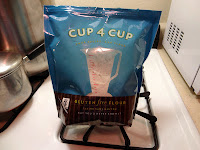 My mom loves Starbuck's seasonal cranberry bliss bars, but unfortunately she recently has become sensitive to wheat gluten. For Christmas, I set about researching how to make some gluten-free bars.
My mom loves Starbuck's seasonal cranberry bliss bars, but unfortunately she recently has become sensitive to wheat gluten. For Christmas, I set about researching how to make some gluten-free bars.In case you haven't heard of the Starbuck's cranberry bliss bar, it is only available around Christmas and it seems to be one of the most universally beloved baked goods they offer. Cranberries, cream cheese frosting, and chunks of white chocolate make for a nice balance of sweet, savory, and tart.
My mom is a sucker for anything cranberry, so this is a guilty pleasure for my mother, and she is very tempted every holiday season. Much to my mother's surprise, there is actually tons of reliable copy-cat recipes posted on the internet already. However, I was looking for a jumping-off point that I could use to make a gluten free recipe. And a good gluten-free flour to use. On a suggestion, I picked up a bag of Cup4Cup from William's Sonoma. On the record, this isn't a sponsored push for the product, but I was exceedingly pleased with the results.
Tragedy struck while making this recipe: while preheating the oven, my friend said, "Hey... I smell gas."
My oven has been periodically giving up on me, or taking 20 minutes to get to the proper temperature, but that day it finally officially died on me. We had to open all the windows since I was accidentally trying to gas us all to death, and I had to hope that a couple days in the fridge wouldn't harm the bar batter.
I brought it over to my parent's house to bake, and thankfully I can report that you can refrigerate the base for several days before baking, if needed. Just increase the bake time by about 10 minutes.







